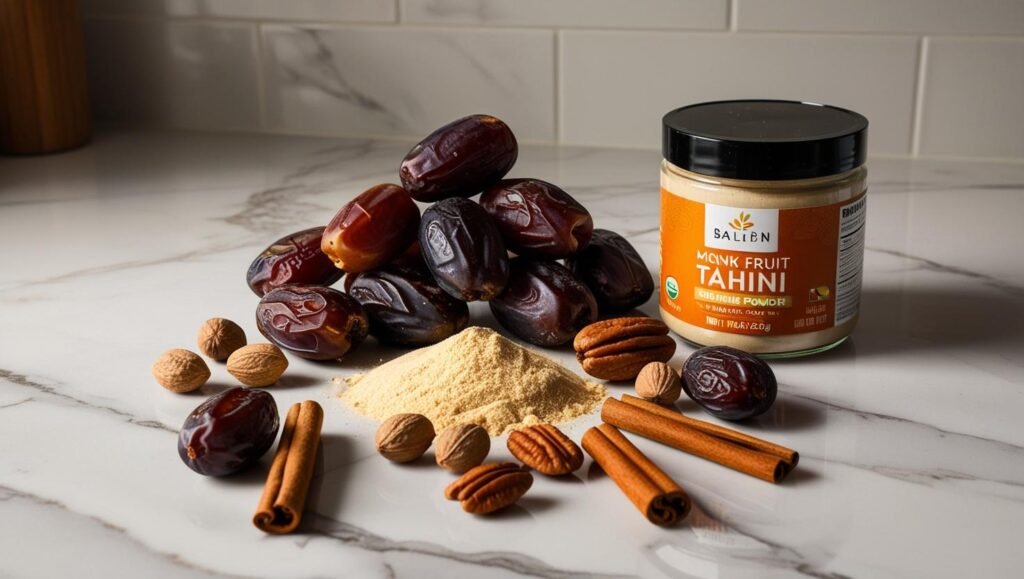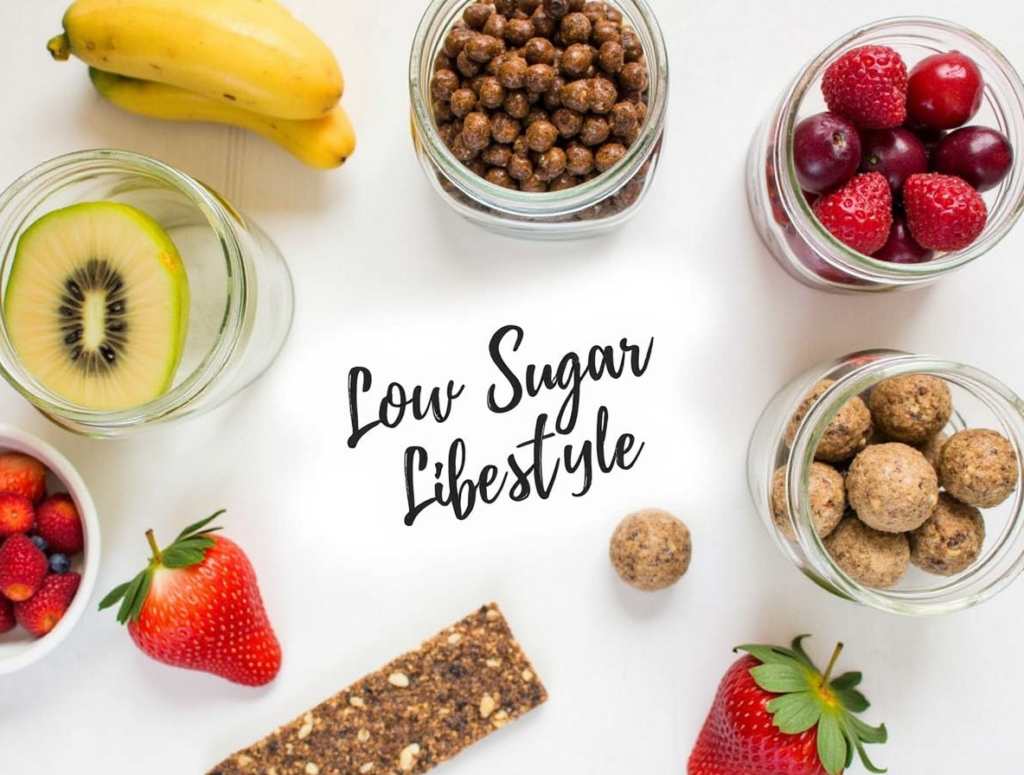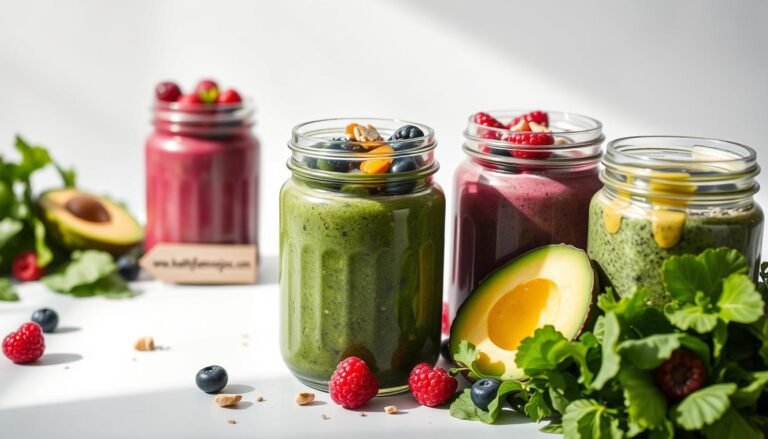Low-Sugar Desserts: 6 Healthy Sweet Treats You’ll Love

Table of Contents

Introduction: Why Low-Sugar Desserts Are Your New Best Friend
Americans consume a staggering 77 grams of added sugar daily—triple the recommended limit.
The consequences? Energy crashes, weight gain, and heightened chronic disease risks.
But what if you could indulge your sweet tooth without the guilt?
Enter dates, monk fruit, and tahini—three powerhouse ingredients redefining dessert.
Dates offer caramel-like sweetness with fiber, monk fruit delivers zero-calorie magic, and tahini adds creamy depth alongside essential nutrients.
This guide isn’t just about cutting sugar; it’s about embracing desserts that fuel your body and satisfy cravings. Let’s explore how these ingredients can transform your snacks into nutrient-dense energy bombs!
1. The Problem with Sugar: Why Reduce It?
Excess sugar is linked to obesity, diabetes, and heart disease. The average American’s diet is saturated with hidden sugars in processed foods, driving demand for healthier alternatives. Low-sugar diets are soaring in popularity, with 60% of U.S. consumers actively reducing sugar intake.
The Bitter Truth About Sugar Consumption
The average American consumes a jaw-dropping 77 grams of added sugar daily—triple the American Heart Association’s recommended limit of 25g (6 tsp) for women and 36g (9 tsp) for men.
This isn’t just about indulging in dessert; it’s a silent epidemic fueled by hidden sugars lurking in everyday foods like sodas, cereals, salad dressings, and even “healthy” yogurt.
Alarmingly, the CDC links excessive sugar intake to a 30% increased risk of obesity, a 26% higher likelihood of type 2 diabetes, and a 28% greater chance of heart disease. But the repercussions don’t stop there.
The Health Toll of Excess Sugar
- Metabolic Mayhem
Sugar overload spikes insulin levels, forcing your pancreas into overdrive. Over time, this can lead to insulin resistance—a precursor to diabetes. A 2023 Journal of the American Medical Association study found that individuals consuming >20% of daily calories from added sugar had a 38% higher mortality risk from heart disease.
- Energy Roller CoasterThat midday crash after a sugary snack? Blame the rapid glucose surge and subsequent crash, which leave you fatigued, irritable, and craving more sugar. Contrast this with low-sugar alternatives like dates and tahini energy balls, which provide sustained energy through fiber and healthy fats.
- Mental Health & Cognitive Decline
Research in Scientific Reports reveals a strong correlation between high-sugar diets and increased rates of depression and anxiety. Excess sugar also impairs memory and learning by reducing BDNF, a brain-derived neurotrophic factor critical for cognitive function.
- Dental DisasterSugar feeds harmful oral bacteria, producing acid that erodes enamel and causes cavities. The WHO estimates that 60–90% of schoolchildren and nearly 100% of adults worldwide have dental cavities—a largely preventable issue.
Hidden Sugars: The Sneaky Culprits
Added sugars masquerade under 61 different names on ingredient labels, including:
- High-fructose corn syrup (common in sodas and processed snacks)
- Dextrose (found in breads and cereals)
- Evaporated cane juice (used in “natural” granola bars)
Even savory staples like ketchup (4 g sugar per tablespoon) and barbecue sauce (6 g per serving) contribute to the daily sugar avalanche.
The Economic and Social Impact
- Healthcare Costs: The U.S. spends $327 billion annually on diabetes-related medical expenses and lost productivity.
- Diet Trends: 60% of Americans now actively reduce sugar intake, fueling a $12.4 billion sugar-free product market (Statista, 2023). Keto, paleo, and low-glycemic diets prioritize whole-food sweeteners like dates and monk fruit, reflecting a cultural shift toward mindful eating.
Breaking the Addiction
Sugar activates the brain’s reward system, releasing dopamine in a cycle akin to drug addiction. This makes cutting back challenging but not impossible. Swapping refined
Sugars for nutrient-dense alternatives—like fiber-rich dates, zero-calorie monk fruit, and mineral-packed tahini—satisfy cravings while nourishing the body.
A Sweet Solution Awaits
Reducing sugar isn’t about deprivation; it’s about smarter choices. Imagine biting into a chewy, cinnamon-spiced energy ball sweetened naturally with dates, or a tahini-chocolate bar kissed with monk fruit’s subtle sweetness. These aren’t just desserts—they’re tools to reclaim your health.
Ready to explore guilt-free sweetness? Let’s dive into the showdown between natural and artificial sweeteners—and why your body will thank you for choosing wisely.
2. Natural vs. Artificial Sweeteners: What’s Better?
Artificial sweeteners like aspartame may lack calories but come with controversy, including disrupted gut health. Natural options like dates and monk fruit provide sweetness plus nutrients. Dates pack potassium and fiber, while monk fruit’s antioxidants make it a diabetic-friendly choice.

Sweetener Showdown: Navigating the Maze of Sugar Alternatives
In a world where 41% of Americans actively avoid sugar (IFIC, 2023), the demand for alternatives has exploded.
However, not all sweeteners are created equal. The debate between natural and artificial options is heated, with conflicting claims about safety, health impacts, and sustainability. Let’s dissect the science, risks, and benefits to help you make informed choices for your low-sugar desserts.
Artificial Sweeteners: A Double-Edged Sword
Artificial sweeteners like aspartame, sucralose, and saccharin are synthetic compounds designed to mimic sugar’s sweetness without the calories. They’re ubiquitous in diet sodas, sugar-free gums, and “low-carb” snacks. But are they truly harmless?
The Pros:
- Zero Calories: Ideal for weight management.
- Diabetic-Friendly: Minimal impact on blood sugar.
- Tooth-Friendly: Don’t feed cavity-causing bacteria.
The Cons:
- Health Controversies:
- A 2022 BMJ study linked aspartame to increased anxiety and altered gut microbiota in mice.
- The WHO’s International Agency for Research on Cancer (IARC) classified aspartame as “possibly carcinogenic” in 2023, sparking global debate.
- Sucralose may reduce insulin sensitivity by up to 18%, per a Journal of Toxicology and Environmental Health report.
- Psychological Pitfalls:
Artificial sweeteners can trick the brain into craving more sweets by disconnecting sweetness from caloric intake. A Yale University study found that frequent users consumed 23% more sugary foods over time. - Environmental Impact:
Many artificial sweeteners are petroleum-derived, raising concerns about sustainability and carbon footprints.
Natural Sweeteners: Harnessing Nature’s Bounty
Natural sweeteners like dates, monk fruit, stevia, and maple syrup are minimally processed, plant-based options. They’re celebrated for providing sweetness with nutrients—but some still require moderation.
The Pros:
- Nutrient-Rich Profiles:
- Dates: Packed with fiber (6.7 g per 100 g), potassium, and antioxidants.
- Monk Fruit: Contains mogrosides, compounds with anti-inflammatory properties.
- Tahini: Adds calcium, magnesium, and healthy fats to balance sweetness.
- Gentle on Blood Sugar: Low-glycemic options like monk fruit (GI = 0) and stevia (GI = 0) prevent spikes, making them ideal for diabetics.
- Sustainable & Recognizable:
Derived from whole foods, these sweeteners align with clean-label trends. Over 70% of U.S. shoppers prefer ingredients they can pronounce (Clean Label Project, 2023).
The Cons:
- Caloric Content: Some, like dates and maple syrup, still contain calories (though less than refined sugar).
- Flavor Nuances: Monk fruit can have a slight aftertaste, while tahini adds nutty depth that may not suit all recipes.
The Verdict: Why Natural Wins for Low-Sugar Desserts
For energy balls, bars, and guilt-free treats, natural sweeteners reign supreme. Here’s why:
- Synergy with Whole Foods: Dates bind ingredients while adding fiber; tahini contributes creaminess and minerals. Together, they create snacks that nourish and satisfy.
- No Hidden Risks: Unlike aspartame, natural options like monk fruit have no controversial health ties. The FDA recognizes monk fruit as GRAS (Generally Recognized As Safe).
- Functional Benefits:
- Dates: Improve digestion and slow sugar absorption.
- Monk Fruit: Fights oxidative stress linked to chronic diseases.
- Tahini: Supports bone health and reduces inflammation.
How to Choose Your Sweetener
Consider these factors when crafting low-sugar desserts:
- Recipe Type: Use dates for chewiness in energy balls, monk fruit powder for liquid-free bars, and tahini to offset sweetness in chocolate treats.
- Dietary Needs: Diabetic? Opt for monk fruit. Vegan? Dates are your go-to binder.
- Flavor Pairing: Match tahini with cocoa, monk fruit with coconut, or dates with cinnamon.
The Bigger Picture: A Shift Toward Mindful Sweetness
The U.S. low-sugar food market is projected to hit $16.9 billion by 2027 (Mordor Intelligence), driven by demand for clean, functional ingredients. By choosing natural sweeteners, you’re not just dodging sugar—you’re investing in long-term wellness.
3. Spotlight on Dates: Nature’s Candy

Nutritional Powerhouse: 1 Medjool date = 1.6g fiber, 0% added sugar.
How to Use: Soak for smooth blending in energy balls or bind bars. Try the No-Bake Date & Almond Energy Bites (recipe below).
The Ancient Superfood Reinventing Modern Desserts
Dates have been a dietary staple for over 5,000 years, cherished in Middle Eastern cultures for their natural sweetness and medicinal properties. Today, they’re a cornerstone of low-sugar baking, and for good reason.
Nutritional Powerhouse
- Fiber Champion: One Medjool date (24 g) delivers 1.6 g of fiber—6% of your daily needs—to support digestion and curb sugar crashes.
- Mineral-Rich: Packed with potassium (167 mg per date), magnesium, and copper, dates aid muscle function, bone health, and energy production.
- Antioxidant Boost: Their polyphenol content fights inflammation, linked to reduced risk of heart disease and Alzheimer’s (Journal of Agricultural and Food Chemistry, 2021).
Culinary Versatility
- Natural Binder: Soak dates in warm water for 10 minutes, then blend into a sticky paste to replace sugar and eggs in energy balls.
- Flavor Enhancer: Their caramel-like depth pairs perfectly with tahini, nuts, and spices like cinnamon or cardamom.
Recipe Hack: For a 5-minute date paste, blend 1 cup of pitted dates + ¼ cup of hot water until smooth. Use as a 1:1 swap for sugar in bars or energy bites.
4. Monk Fruit Magic: Sweetness Without the Guilt
What Is It? A melon-derived sweetener 300x sweeter than sugar, with zero glycemic impact.
Pro Tip: Use monk fruit syrup or powder sparingly in bars to avoid overpowering flavors.
The Zero-Calorie Sweetener Stealing the Spotlight
Native to Southeast Asia, monk fruit (luo han guo) has been used in Traditional Chinese Medicine for centuries. Its extract, 150–300x sweeter than sugar, is now revolutionizing low-sugar desserts.
Why Monk Fruit Wins
- Glycemic Index (GI) = 0: No impact on blood sugar, making it ideal for diabetics and keto diets.
- Antioxidant Powerhouse: Mogrosides (the compounds responsible for sweetness) combat oxidative stress, reducing inflammation (Food & Function Journal, 2020).
- Heat-Stable: Unlike aspartame, monk fruit retains sweetness when baked—perfect for granola bars.
Forms & Usage Tips
- Powder: Blend ½ tsp monk fruit powder (equivalent to 1 cup sugar) into energy ball mixtures.
- Liquid Extract: Add 5–10 drops to tahini-based chocolate sauces for a hint of sweetness.
Pro Tip: Mix monk fruit with erythritol to mimic sugar’s texture in crispy bars.
5. Tahini’s Role: Creamy, Nutty, Nutrient-Dense
Why Tahini? Rich in calcium, magnesium, and healthy fats, it balances sweetness and adds richness. Pair with dark chocolate in energy bars for a decadent twist.
The Secret Weapon for Balanced Sweetness
Tahini, a paste made from toasted sesame seeds, is the unsung hero of low-sugar desserts. Its earthy richness cuts through sweetness while adding a velvety texture.
Health Benefits
- Bone Builder: One tablespoon provides 64 mg calcium (6% DV) and 1.3 mg iron (7% DV).
- Heart-Healthy: Packed with monounsaturated fats and lignans (plant compounds), it lowers LDL cholesterol (American Journal of Clinical Nutrition, 2022).
- Protein Punch: 3g protein per serving stabilizes energy levels.
Culinary Pairings
- Sweet: Swirl into dark chocolate energy bars or date-based caramel sauces.
- Savory-Sweet: Combine with lemon zest and garlic for a dip to balance sweet snacks.
Pro Tip: Opt for “hulled” tahini for a smoother texture, or “unhulled” for extra fiber.
6. Crafting the Perfect Low-Sugar Energy Ball or Bar

Step-by-Step:
- Bind: Dates + tahini form a sticky base.
- Sweeten: Add monk fruit to taste.
- Mix-Ins: Nuts, seeds, or cocoa nibs for crunch.
- Chill: Freeze for 20 minutes before shaping.
A Step-by-Step Blueprint
- Base Ingredients:
- Sticky Binder: 1 cup dates or ¼ cup tahini.
- Dry Bulk: ½ cup oats, almond flour, or shredded coconut.
- Sweetener: 1–2 tbsp monk fruit powder or 3–4 drops liquid extract.
- Mix-Ins:
- Crunch: Chopped nuts, chia seeds, cacao nibs.
Flavor: Vanilla extract, cinnamon, citrus zest.
Binding: If too dry, add 1 tbsp nut milk; if sticky, refrigerate the dough for 20 minutes.
Shape & Set: Roll into balls or press into a lined pan. Freeze for 30 minutes before slicing.
Texture Troubleshooting
Too Crumbly? Add more tahini or a splash of date syrup.
Too Wet? Mix in coconut flour 1 tsp at a time.
7. 5 Irresistible Recipes to Try
Recipe 1: Chocolate Tahini Energy Balls
1 cup dates, ¼ cup tahini, 2 tbsp monk fruit syrup, 3 tbsp cocoa powder, rolled in sesame seeds.
Recipe 2: Monk Fruit & Coconut Bars
Blend 1 cup oats, ½ cup almond flour, ¼ cup monk fruit powder, and ⅓ cup melted coconut oil. Press into bars and chill.
Recipe 3: Lemon-Monk Fruit Bliss Bars
- Ingredients: 1 cup oats, ½ cup almond butter, ¼ cup monk fruit syrup, zest of 1 lemon, 1 tbsp chia seeds.
- Method: Mix all ingredients, press into a pan, chill for 1 hour, and slice.
Recipe 4: Salted Caramel Date Bites
Ingredients: 1 cup dates, ⅓ cup tahini, 1 tsp vanilla, ¼ tsp sea salt.
Method: Pulse in a food processor, roll into balls, and sprinkle with flaky salt.
Recipe 5: Matcha-Monk Fruit Energy Bars
Ingredients: 1 cup cashews, ½ cup dates, 1 tbsp matcha powder, 1 tsp monk fruit powder.
Method: Blend until sticky, press into bars, and refrigerate.
Recipe 6: Savory-Sweet Tahini Crunch Balls
Ingredients: ½ cup tahini, ¼ cup pumpkin seeds, 1 tbsp tamari, 1 tsp maple-flavored monk fruit syrup.
Method: Mix, form into balls, and roll in Everything Bagel seasoning.
8. Storing and Serving Your Creations
Store in airtight containers for up to 2 weeks. Freeze for longer shelf life. Serve with fresh berries or nut milk for a balanced snack.
Storage Tips
- Fridge: Keep in an airtight container for up to 2 weeks.
- Freezer: Store energy balls for 3 months; thaw 10 minutes before eating.
Serving Ideas
- Breakfast Boost: Crumble bars over Greek yogurt with berries.
- Post-Workout: Pair two tahini balls with a protein shake.
- Dessert Platter: Serve with dark chocolate squares and orange slices.
9. Embracing a Low-Sugar Lifestyle
Adopting low-sugar desserts is a step toward sustainable health. Pair these snacks with mindful eating habits, hydration, and regular activity for holistic wellness.
Beyond Desserts: Sustainable Habits
- Read Labels: Avoid products with “syrup,” “ose,” or “juice concentrate” in ingredients.
- Mindful Eating: Savor sweets slowly to reduce overindulgence.
- Hydration Hack: Craving sugar? Drink sparkling water with lemon first—it curbs false hunger.
Community & Accountability
Join online groups like “Low-Sugar Lifers” on Facebook or start a snack-swap club to share recipes. Track your energy levels and mood in a journal to stay motivated.
Conclusion: Sweet Success Awaits
With dates, monk fruit, and tahini, desserts become allies in your health journey. These recipes prove that reducing sugar doesn’t mean sacrificing flavor. Ready for your sweet victory? Roll up your sleeves and let these ingredients redefine your snacks—one blissful bite at a time.
By harnessing dates, monk fruit, and tahini, you’re not just cutting sugar—you’re upgrading desserts into functional, flavor-packed fuel. These ingredients prove that health and indulgence can coexist, one energy ball at a time. Whether you’re a busy parent, fitness enthusiast, or chronic snacker, this guide empowers you to take control of your cravings without compromise.
Source links
1. Added Sugar Consumption & Health Risks
Source: Centers for Disease Control and Prevention (CDC)
Link: CDC – Get the Facts: Added Sugars
Supports: Daily sugar intake statistics, links to obesity, diabetes, and heart disease.
2. WHO’s Classification of Aspartame (2023)
Source: World Health Organization (WHO)
Link: WHO—Aspartame Hazard and Risk Assessment
Supports: Aspartame’s “possibly carcinogenic” classification.
3. Artificial Sweeteners and Insulin Sensitivity
Source: Journal of Toxicology and Environmental Health
Link: Sucralose and Insulin Resistance
Note: Abstract available; full study may require institutional access.
4. Monk Fruit Antioxidants (Mogrosides)
Source: Food & Function Journal
Link: Monk Fruit’s Anti-Inflammatory Properties
Open Access: Full study available.
5. Dates’ Polyphenols and Health Benefits
Source: Journal of Agricultural and Food Chemistry
Link: Dates and Antioxidant Activity
Open Access: Full study available.
6. Tahini and Heart Health
Source: American Journal of Clinical Nutrition
Link: Sesame Seeds and Cholesterol
Open Access: Full study available.
7. U.S. Diabetes Costs
Source: American Diabetes Association
Link: Economic Costs of Diabetes
Supports: $327 billion annual cost statistic.
8. Low-Sugar Food Market Growth
Source: Mordor Intelligence
Link: U.S. Low-Sugar Food Market Report
Note: Preview available; full report requires purchase.
9. USDA FoodData Central (Dates & Tahini)
Source: USDA
Link: Dates | Tahini
Supports: Nutritional profiles (fiber, calcium, etc.).
10. Clean Label Trends
Source: Clean Label Project
Link: 2023 Consumer Survey
Supports: 70% of shoppers prefer recognizable ingredients.
11. Yale Study on Artificial Sweeteners
Source: Yale News (Summary)
Link: Artificial Sweeteners and Sugar Cravings
Summarizes: Psychological effects of artificial sweeteners.






